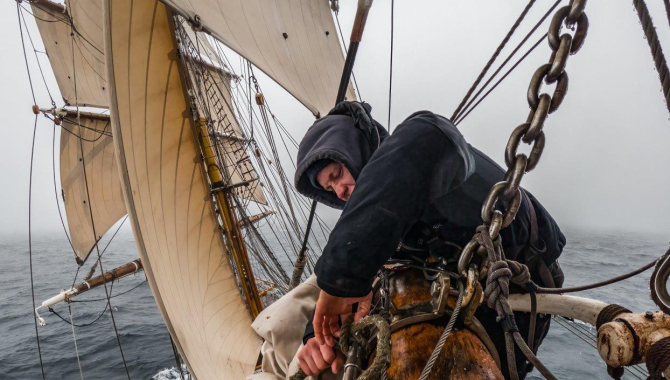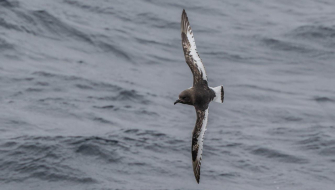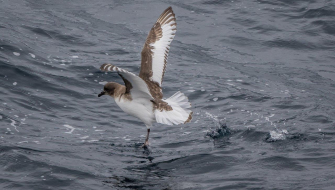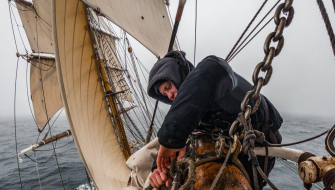Wind backs to westerly again.

Steering now on a southwest direction. Wearing ship on increasing winds and seas just before encountering again the Weddell Sea pack ice.
Wind backs to westerly again. Steering now on a southwest direction. Wearing ship on increasing winds and seas just before encountering again the Weddell Sea pack ice.
Less famous than its neighbour Drake Passage, the Scotia Sea shows similar moods and temperamental seas and weather. Its southern region, usually blanketed by pack ice and where large icebergs drift off the Weddell Sea carried by the northern flow of its ocean current clockwise gyre. Its waters are part of the windy latitudes of the Furious 50s and bounded by the parallel where the Screeching 60s begin. Predominant westerlies usually blow hard, carrying a train of low-pressure systems.
And here the Europa tries to sail upwind, from South Georgia to Antarctica, dealing with ice and variable winds that most of the time blow on her face, others back and veer depending on the relative positions of the meteorological systems around her.

Yesterday she motorsailed westwards on the abating winds that eventually turned to southerlies. Before that, she spent days wearing and changing course north to south and back again, waiting for a change in the conditions. Today she motors her way on a southwesterly course as the wind has veered to a westerly. In the afternoon, her engines become silent and she sails under topsails, topgallants, main course, lower and middle staysails, headrig, and spanker.
A few days ago, 50kn gusts swept over her decks and rig; today a steady 20kn blow. By the evening and overnight, it climbs up to over 30kn, while the seas grow too. At the same time, the edge of the pack ice shows up on the radar a few miles ahead of us.
Gusty, windy, snowy, foggy, icy, or cold, the seas where we sail represent an unbeatable area and a great chance both for the hard sailing and routing of a trip and also for enjoying the summer richness of its waters. Again today, humpbacks and fin whales are seen at a distance, and around the ship, a cloud of seabirds fly. Including the rare sights of some albatrosses this far south and so close to the pack ice, and of a handful of the uncommon Antarctic petrels, amongst their relatives the Cape petrels and the numerous prions. Sure, many of those seabirds have their nests at the South Orkney Islands, today just about 89nm south of us, but the sea surrounding the islands is packed with ice, so they need to find the open waters along its edge to look for food. Others probably come flying from further away: Elephant Island lays 249nm westwards, or the Antarctic Peninsula, 369nm away from us, or even South Georgia, or who knows — many of those species are really ocean wanderers, enjoying the winds and rigours of the Southern Ocean.
Just about to encounter the edge of the Weddell Sea pack ice, after dinner it is time again to wear ship and head to a more northwesterly direction. Topgallants and middle staysails come down, main course is clewed up as well, then we turn the ship with the wind as we pull at coordinated times the main and fore braces, until she points on the new course. Headrig is tightened in the new tack, and off she sails now over the rough seas and strong winds as the night falls. And with it, the biting cold. Shrouds, lines, gaskets — all the rig is freezing over. Even when we climb up to furl the sails we just doused, the canvas is stiff and icy.
All of a set of conditions that haven’t changed much since the first ships ventured into these waters, thereabout the 16th century first, when being blown off their trading routes, or the 1700s when Captain Cook took possession of South Georgia while set in a quest to find a South Continent. But we have to wait until the more modern Exploration Era in polar regions during the late 1800s and early 1900s to see expeditions with cartographic and scientific goals. And here in these waters, no other more relevant than the Scottish Antarctic Expedition led by William Bruce. He refused the invitation to join Scott aboard the Discovery, instead he chose to lead his own Scottish expedition to the Weddell Sea, sailing via the South Orkney Islands.

His interests as a polar explorer never were aimed for the sake of exploration in itself. Now he was in charge of a scientific voyage trying to answer oceanographic and biological questions in that area because so little had been done there.
The expedition lasted two years (1902-1904), on board the refitted Norwegian barque renamed Scotia.
In his plans was to overwinter in Laurie Island (South Orkneys), where to have a central point to depart on his Antarctic voyages. Bruce built a hut there, the Omond House, that eventually would become the first Antarctic Station. This little base point for his expedition was transferred to the Argentine government in 1904, and it has been permanently occupied since.
He managed two incursions into the Weddell Sea and was the first one to visit the Antarctic area that forms the eastern shore of the Weddell Sea. He named it Coats Land for James Coats Jr., and Major Andrew Coats, the two chief supporters of the expedition. And later on, the 900,000 km² expanse of cold, stormy, and icy ocean that lays between the Drake Passage, Tierra del Fuego, South Georgia, the South Sandwich Islands, the South Orkney Islands, and the Antarctic Peninsula was given the name of his ship, the Scotia.
